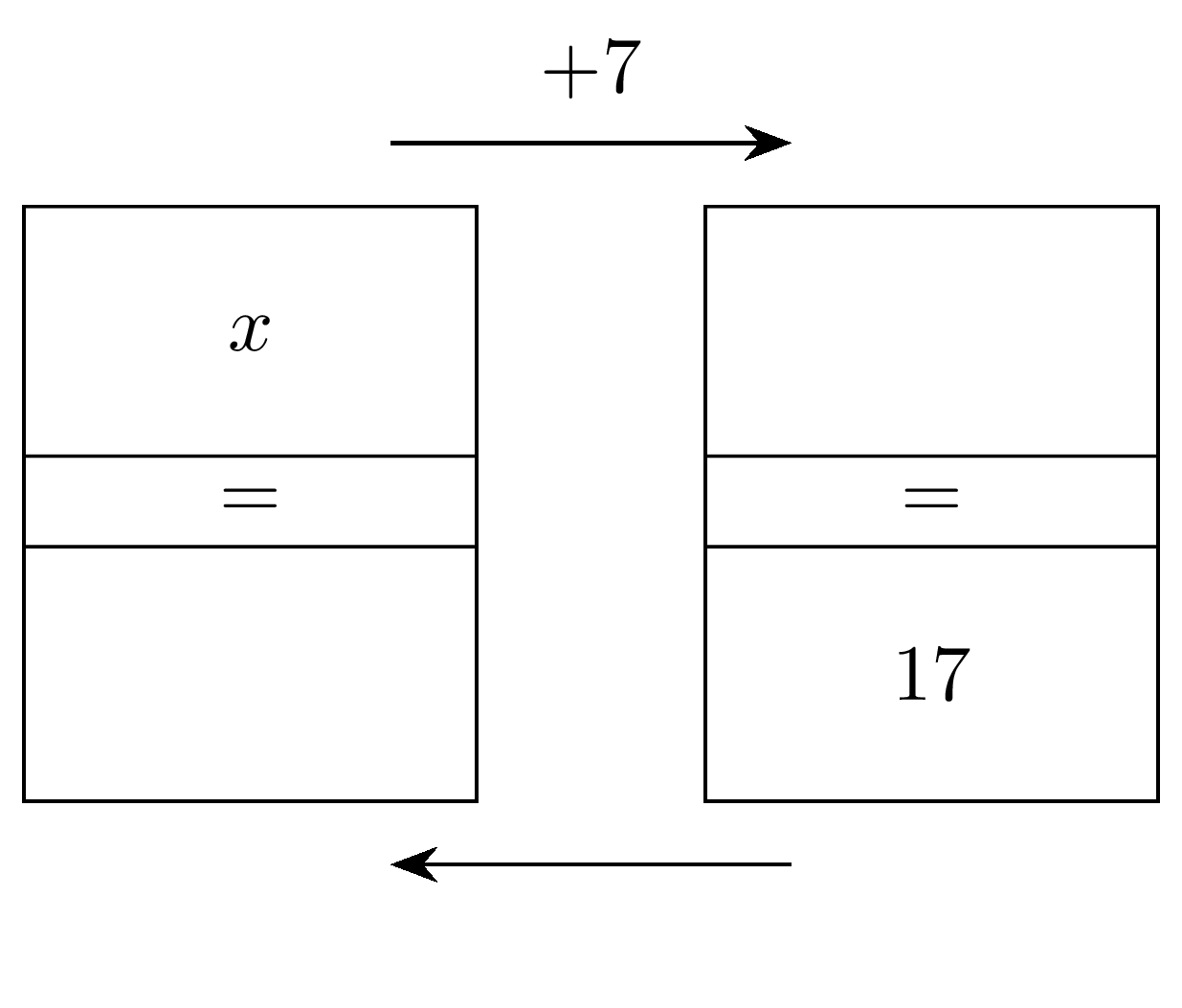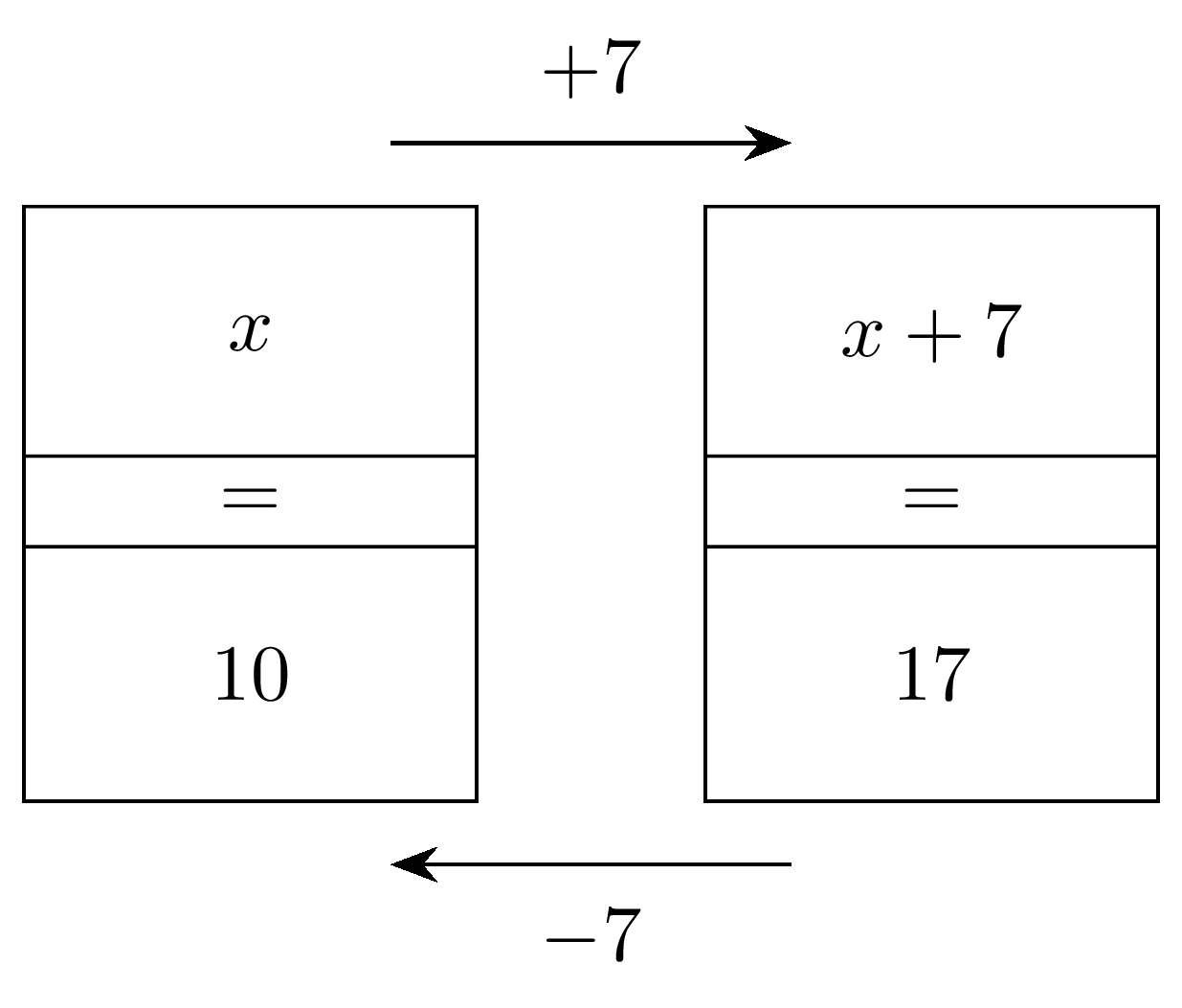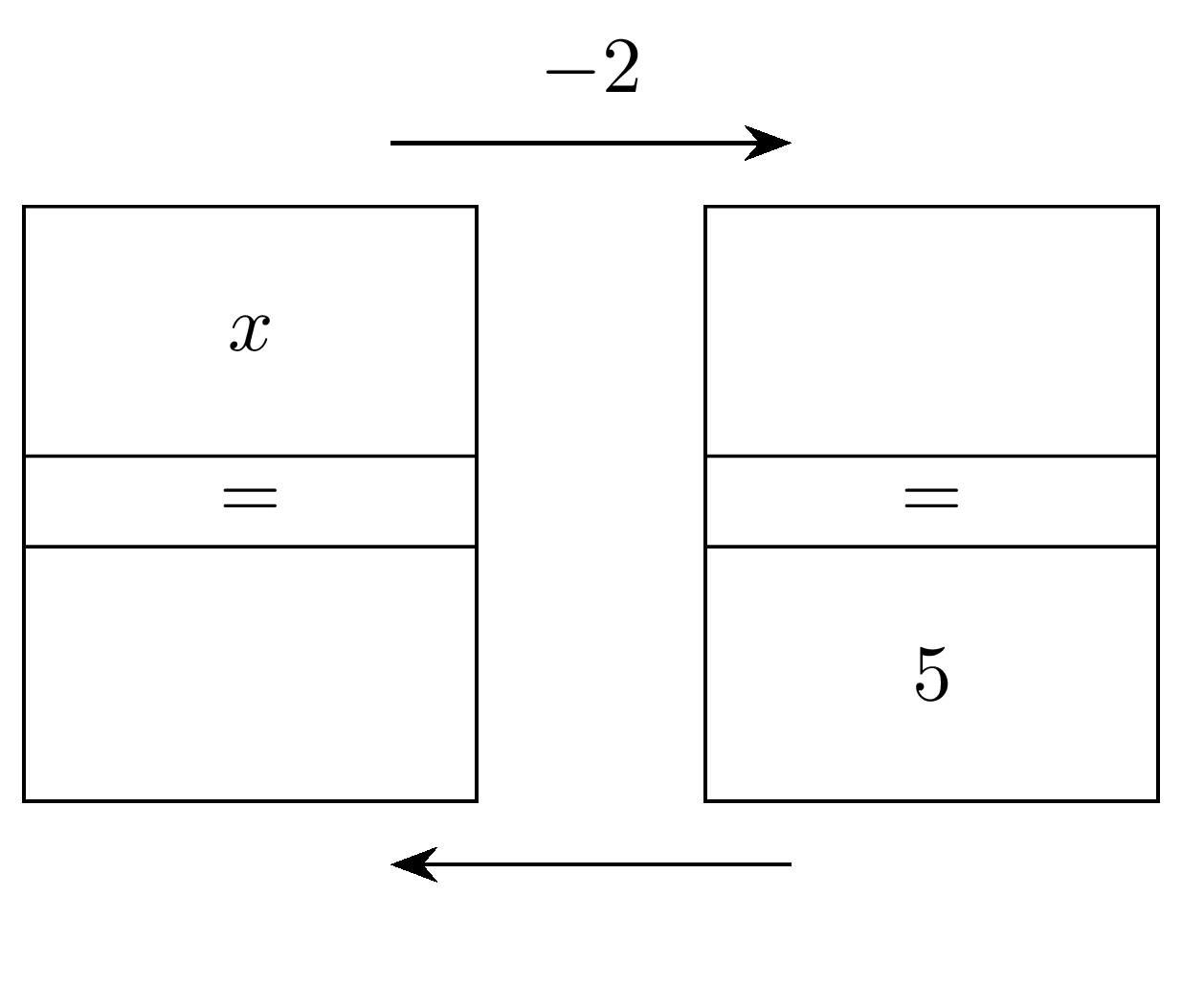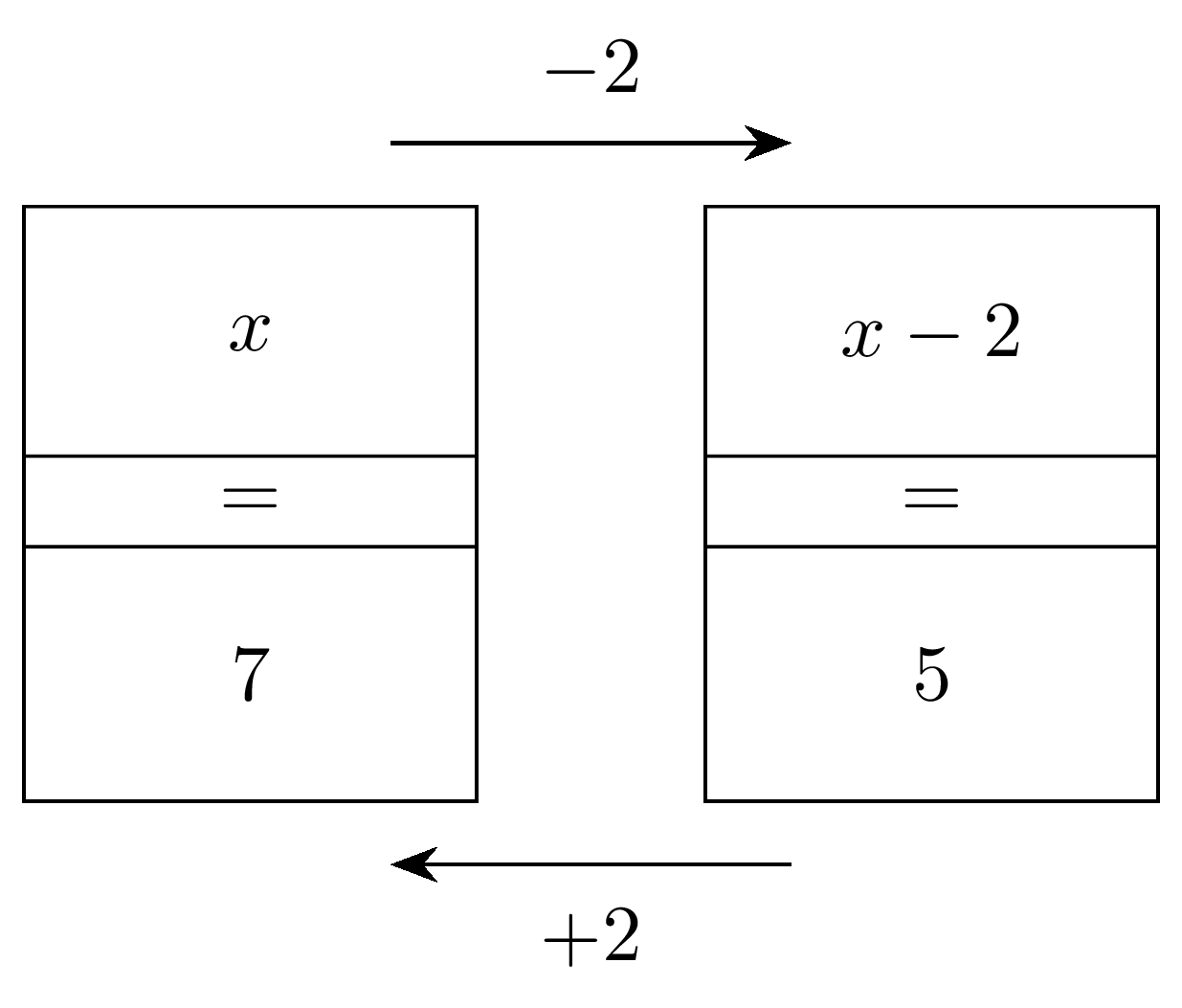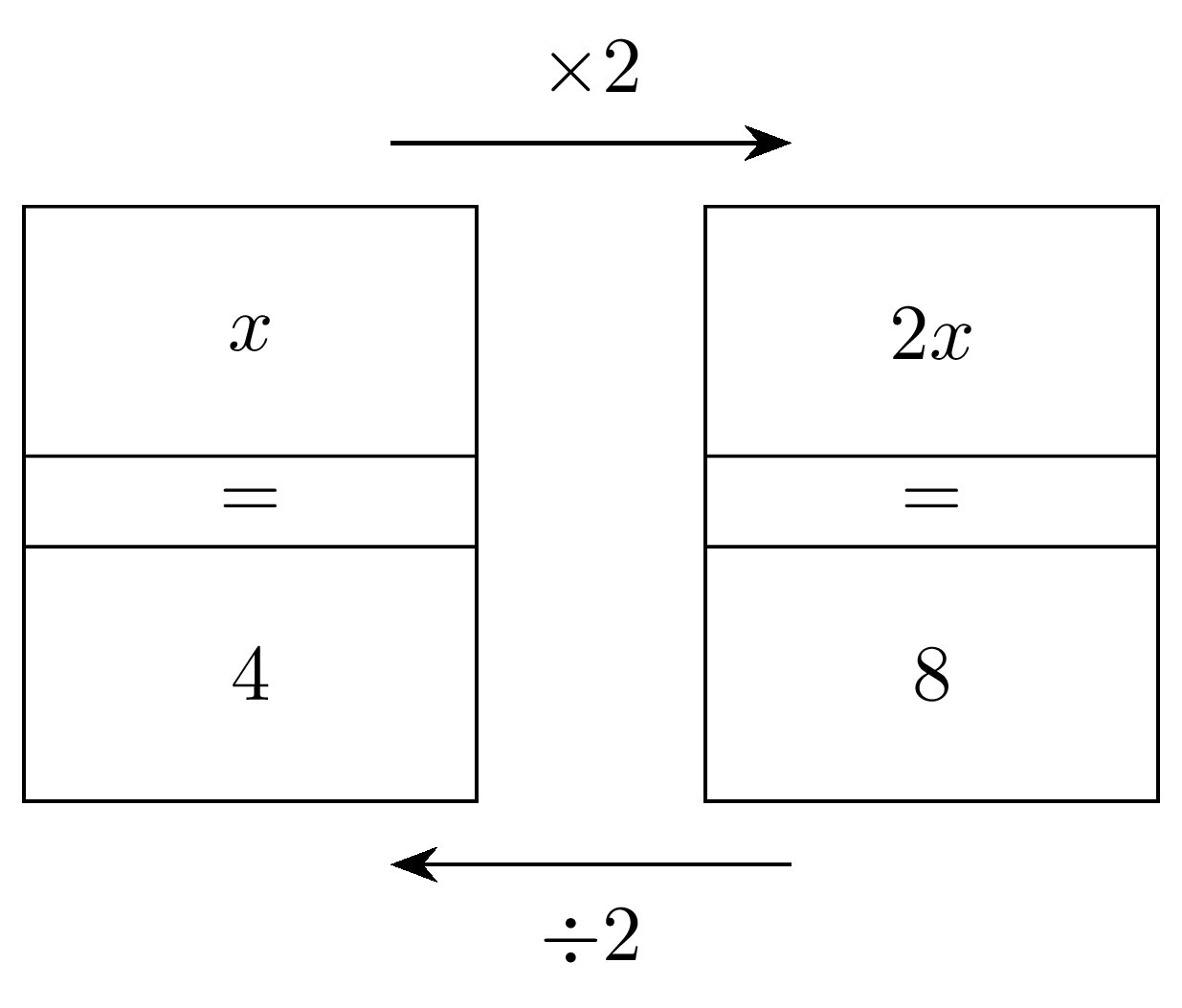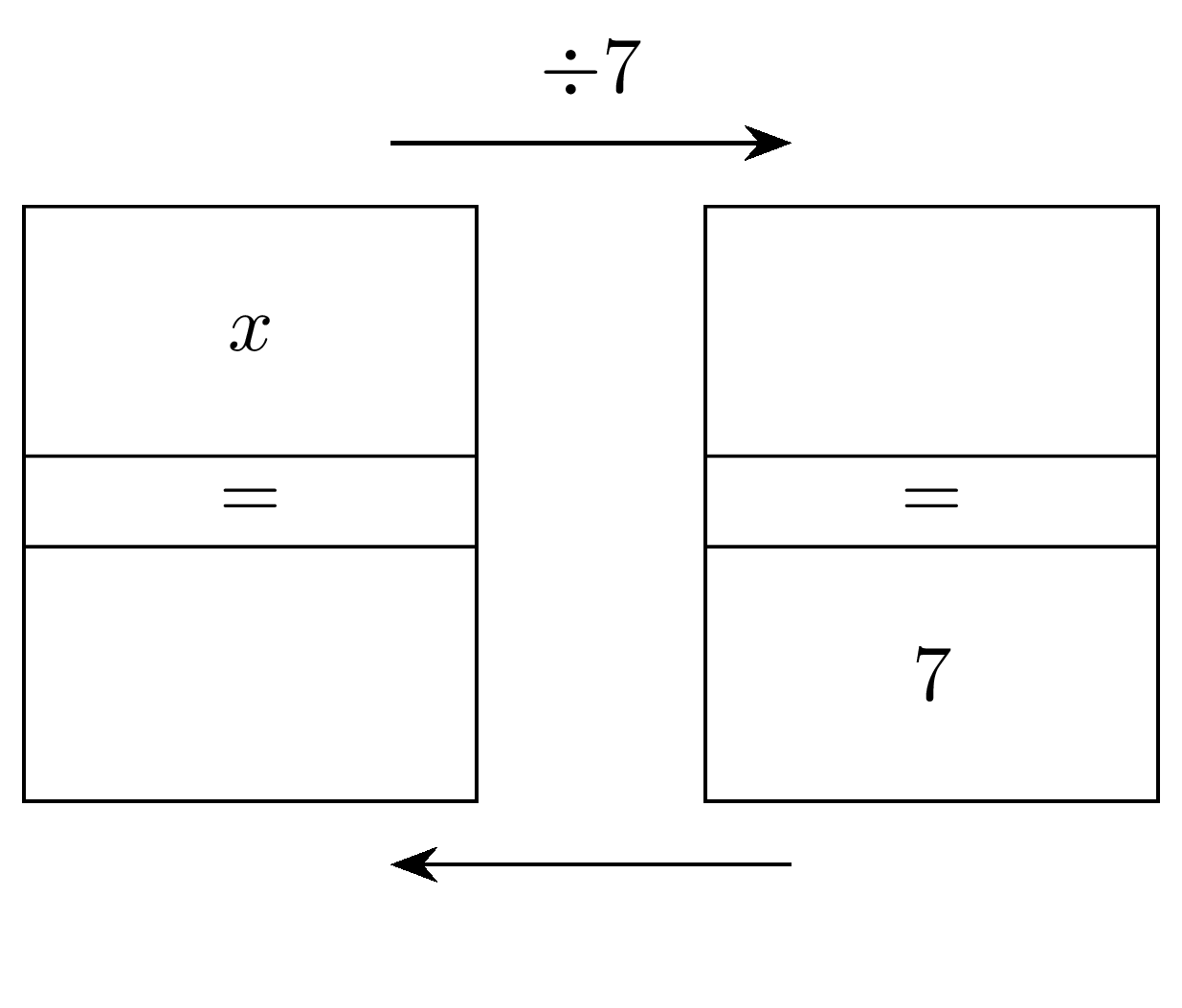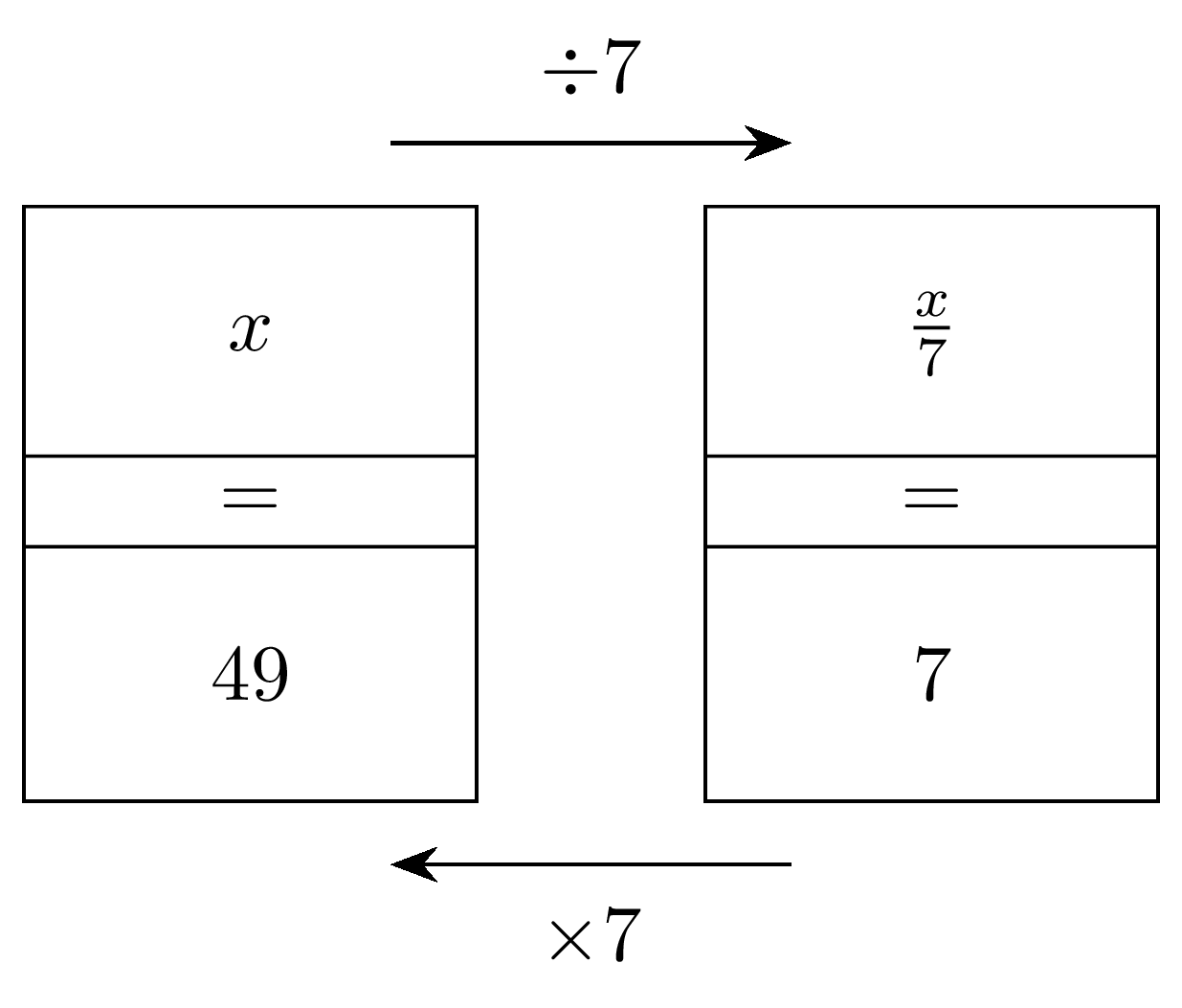3. Backtracking 1 step diagram - automated
"Enter 1, 2, 3, 4 or 5 for +, -, X, /, random""Enter the base filename to be added to the prefix bt1_:".3.1. A 1-step backtracking diagram with answers
3.2. Splitting the LaTeX and modifying it for python
3.2.1. Document template
1% backtracking worksheet template
2\documentclass[border = 1mm]{standalone}
3\usepackage{tikz}
4\usetikzlibrary{positioning}
5\usetikzlibrary {arrows.meta}
6
7\tikzset{backtrack/.style={rectangle,draw=black,fill=white,
8inner sep=2pt,minimum height=32pt, minimum width=20mm}}
9\tikzset{backtrackeq/.style={rectangle,draw=black,fill=white,
10inner sep=2pt,minimum height=12pt, minimum width=20mm}}
11\tikzset{backtrackstep/.style={rectangle,draw=none,fill=white,
12inner sep=2pt,minimum height=12pt, minimum width=20mm}}
13
14\begin{document}
15 <<diagram>>
16\end{document}
<<diagram>> is placeholder text for the text that python will use to add the LaTeX for the backtracking diagram.3.2.2. Diagram template
1\begin{tikzpicture}
2
3 \node[backtrack] (boxA) at (0, 0) {$<<boxA>>$};
4 \node[backtrack] (boxB) [right=1cm of boxA] {$<<boxB>>$};
5
6 \node[backtrackeq] (boxAeq) [below=-1pt of boxA] {$=$};
7 \node[backtrackeq] (boxBeq) [below=-1pt of boxB] {$=$};
8
9 \node[backtrack] (boxArev) [below=-1pt of boxAeq] {$<<boxArev>>$};
10 \node[backtrack] (boxBrev) [below=-1pt of boxBeq] {$<<boxBrev>>$};
11
12 \node(boxAr) at ([yshift=24pt,xshift=5mm]boxA) { };
13 \node(boxBl) at ([yshift=24pt,xshift=-5mm]boxB) { };
14 \draw [line width=0.4pt,-{Stealth[length=2mm]}] (boxAr) --node[backtrackstep, above=3.0pt] {$<<stepAB>>$} (boxBl);
15
16 \node(boxBrevl) at ([yshift=-24pt,xshift=-5mm]boxBrev) { };
17 \node(boxArevr) at ([yshift=-24pt,xshift=5mm]boxArev) { };
18 \draw [line width=0.4pt,-{Stealth[length=2mm]}] (boxBrevl) --node[backtrackstep, below=3.0pt] {$<<stepABrev>>$} (boxArevr);
19
20\end{tikzpicture}
21
22
23
3.2.3. Example of a placeholder
\node[backtrack] (boxB) [right=1cm of boxA] {$<<boxB>>$} has a placeholder <<boxB>> which is replaced by python.3.2.4. Python to create a 1 step diagram
This Python code requires two user inputs: a1 to 4 to choose the arithmetic operation, and the filename to be used.
The code reads in three template files: tex_template_path, texans_template_path, and tex_diagram_template_path. The contents of these files are stored in the variables tex_template_txt, tex_template_txt_ans, and tex_diagram_template_txt, respectively.
The code then calls the make1_diagram function, passing in tex_diagram_template_txt as an argument. kv = btf.get_1step_process_dict() gets the dictionary containing the values to be placed in the diagram template. The make1_diagram function generates a diagram and returns two values: diagram_text and diagram_text_ans. These values are then used to replace the <<diagram>> placeholder in the tex_template_txt and tex_template_txt_ans variables.
The resulting text is then written to two output files: tex_output_path and tex_output_path_ans.
The code then waits for 1 second to ensure that the files have been created before calling the convert_to_pdf function to convert these TeX files to PDFs. The PDFs are saved to the paths specified by the pdf_path and pdf_path_ans variables.
After waiting for another second, the code calls the magick_pdf_to_png.convert_pdf_to_png function to convert the PDFs to PNGs. The PNGs are saved to the paths specified by the png_path and png_path_ans variables.
The script prints “starting” and “finished” messages to indicate when it begins and ends its execution.
1from pathlib import Path
2import subprocess
3import time
4import random
5import magick_pdf_to_png
6import backtracking_functions as btf
7
8currfile_dir = Path(__file__).parent
9tex_template_path = currfile_dir / "backtrack_1step_template.tex"
10texans_template_path = currfile_dir / "backtrack_1step_template.tex"
11tex_diagram_template_path = currfile_dir / "backtrack_1step_diagram_template.tex"
12
13
14def convert_to_pdf(tex_path, currfile_dir, aux_path):
15 """
16 Converts a TeX file to PDF format using pdfLaTeX.
17
18 Args:
19 tex_path (str): The path to the TeX file.
20 currfile_dir (str): The path to the directory where the TeX file is located.
21 aux_path (str): The path to the directory where auxiliary files will be stored.
22
23 Returns:
24 subprocess.CompletedProcess: A subprocess.CompletedProcess object containing information about the completed process.
25
26 Raises:
27 FileNotFoundError: If the TeX file does not exist.
28 subprocess.CalledProcessError: If pdfLaTeX returns a non-zero exit code.
29 """
30 result = subprocess.run(
31 [
32 "pdfLaTeX",
33 tex_path,
34 "-output-directory",
35 currfile_dir,
36 "-aux-directory",
37 aux_path,
38 ],
39 stdout=subprocess.PIPE,
40 )
41
42
43# tex_keys = ['stepAB','stepABrev','boxA','boxB','boxBrev', 'boxArev' ]
44tex_keys_q = ["stepAB", "boxA", "boxBrev"]
45
46
47def make1_diagram(tex_diagram_template_txt, num):
48 tex_diagram_template_txt_ans = tex_diagram_template_txt
49 kv = btf.get_1step_process_dict(num)
50 for key, value in kv.items():
51 tex_diagram_template_txt_ans = tex_diagram_template_txt_ans.replace(
52 "<<" + key + ">>", value
53 )
54 for key, value in kv.items():
55 if key in tex_keys_q:
56 tex_diagram_template_txt = tex_diagram_template_txt.replace(
57 "<<" + key + ">>", value
58 )
59 else:
60 tex_diagram_template_txt = tex_diagram_template_txt.replace(
61 "<<" + key + ">>", ""
62 )
63 return tex_diagram_template_txt, tex_diagram_template_txt_ans
64
65
66def main():
67 num = input("Enter 1, 2, 3, 4 or 5 for +, -, X, /, random \n")
68 if num.strip().isdigit():
69 num = int(num)
70 if not num in [1, 2, 3, 4, 5]:
71 num = 5 # random by default
72 else:
73 num = 5 # random by default
74 filename = input("Enter the base filename to be added to the prefix bt1_: \n")
75 if not filename:
76 filename = "1" # "bt1_1_q and bt1_1_ans as default file"
77 # set names of files that are made
78 # questions
79 tex_output_path = currfile_dir / f"bt1_{filename}_q.tex"
80 pdf_path = currfile_dir / f"bt1_{filename}_q.pdf"
81 png_path = currfile_dir / f"bt1_{filename}_q.png"
82 aux_path = currfile_dir / "temp"
83 # answers
84 tex_output_path_ans = currfile_dir / f"bt1_{filename}_ans.tex"
85 pdf_path_ans = currfile_dir / f"bt1_{filename}_ans.pdf"
86 png_path_ans = currfile_dir / f"bt1_{filename}_ans.png"
87
88 # Read in the LaTeX template file
89 with open(tex_template_path, "r") as infile:
90 tex_template_txt = infile.read()
91 # Read in the LaTeX template file for answers
92 with open(texans_template_path, "r") as infile:
93 tex_template_txt_ans = infile.read()
94 # Read in the LaTeX diagram template file
95 with open(tex_diagram_template_path, "r") as infile:
96 tex_diagram_template_txt = infile.read()
97
98 # Generate the <<diagram>> replacement tex
99 diagram_text, diagram_text_ans = make1_diagram(tex_diagram_template_txt, num)
100 # Replace the <<diagram>> placeholder in the LaTeX template
101 tex_template_txt = tex_template_txt.replace("<<diagram>>", diagram_text)
102 tex_template_txt_ans = tex_template_txt_ans.replace("<<diagram>>", diagram_text_ans)
103 # Write the question diagram tex to an output file
104 with open(tex_output_path, "w") as outfile:
105 outfile.write(tex_template_txt)
106 # Write the answer diagram tex to an output file
107 with open(tex_output_path_ans, "w") as outfile:
108 outfile.write(tex_template_txt_ans)
109
110 # Wait for the files to be created
111 time.sleep(1)
112 # convert to pdf
113 convert_to_pdf(tex_output_path, currfile_dir, aux_path)
114 convert_to_pdf(tex_output_path_ans, currfile_dir, aux_path)
115
116 # Wait for the files to be created
117 time.sleep(1)
118 # convert to png
119 magick_pdf_to_png.convert_pdf_to_png(pdf_path, png_path)
120 magick_pdf_to_png.convert_pdf_to_png(pdf_path_ans, png_path_ans)
121
122
123if __name__ == "__main__":
124 print("starting")
125 main()
126 print("finished")
